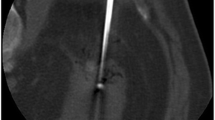Abstract
The technique of using an electrode as a lever to increase the distance between renal cell carcinoma (RCC) and bowel during CT-guided radiofrequency ablation (RFA) is described. CT-guided percutaneous RFA was performed in two patients with two RCCs, which were in close proximity to the adjacent bowel. A sterile drape was placed on the electrode handle following appropriate electrode placement within the tumor in order to displace the kidney upward and to widen the distance to >5 mm between RCC and bowel (RCC-to-bowel distance). In patient 1, the RCC-to-bowel distance increased from 3 mm to 6 mm; in patient 2, from less than 2 mm to 6 mm. Follow-up CT performed 1 month after RFA demonstrated not only complete ablation of the two RCCs but also no thermal injury to the bowel adjacent to the tumors. In conclusion, an electrode might be used as a lever to increase RCC-to-bowel distance during CT-guided RFA by placing a sterile drape on it.


Similar content being viewed by others
References
Gervais DA, McGovern FJ, Arellano RS, McDougal WS, Mueller PR (2005) Radiofrequency ablation of renal cell carcinoma: part 1, Indications, results, and role in patient management over a 6-year period and ablation of 100 tumors. AJR Am J Roentgenol 185:64–71
Livraghi T, Solbiati L, Meloni MF, Gazelle GS, Halpern EF, Goldberg SN (2003) Treatment of focal liver tumors with percutaneous radio-frequency ablation: complications encountered in a multicenter study. Radiology 226:441–451
Farrell MA, Charboneau JW, Callstrom MR, Reading CC, Engen DE, Blute ML (2003) Paranephric water instillation: a technique to prevent bowel injury during percutaneous renal radiofrequency ablation. AJR Am J Roentgenol 181:1315–1317
Kam AW, Littrup PJ, Walther MM, Hvizda J, Wood BJ (2004) Thermal protection during percutaneous thermal ablation of renal cell carcinoma. J Vasc Interv Radiol 15:753–758
Chen EA, Neeman Z, Lee FT, Kam A, Wood B (2006) Thermal protection with 5% dextrose solution blanket during radiofrequency ablation. Cardiovasc Intervent Radiol 29:1093–1096
Boss A, Clasen S, Kuczyk M, Anastasiadis A, Schmidt D, Claussen CD, Schick F, Pereira PL (2005) Thermal damage of the genitofemoral nerve due to radiofrequency ablation of renal cell carcinoma: a potentially avoidable complication. AJR Am J Roentgenol 185:1627–1631
Rhim H, Dodd GD 3rd, Chintapalli KN, Wood BJ, Dupuy DE, Hvizda JL, Sewell PE, Goldberg SN (2004) Radiofrequency thermal ablation of abdominal tumors: lessons learned from complications. Radiographics 24:41–52
Bosniak MA (1986) The current radiological approach to renal cysts. Radiology 158:1–10
Silverman SG, Tuncali K, vanSonnenberg E, Morrison PR, Shankar S, Ramaiya N, Richie JP (2005) Renal tumors: MR imaging-guided percutaneous cryotherapy–initial experience in 23 patients. Radiology 236:716–724
Author information
Authors and Affiliations
Corresponding author
Rights and permissions
About this article
Cite this article
Park, B.K., Kim, C.K. Using an electrode as a lever to increase the distance between renal cell carcinoma and bowel during CT-guided radiofrequency ablation. Eur Radiol 18, 743–746 (2008). https://doi.org/10.1007/s00330-007-0816-6
Received:
Revised:
Accepted:
Published:
Issue Date:
DOI: https://doi.org/10.1007/s00330-007-0816-6




